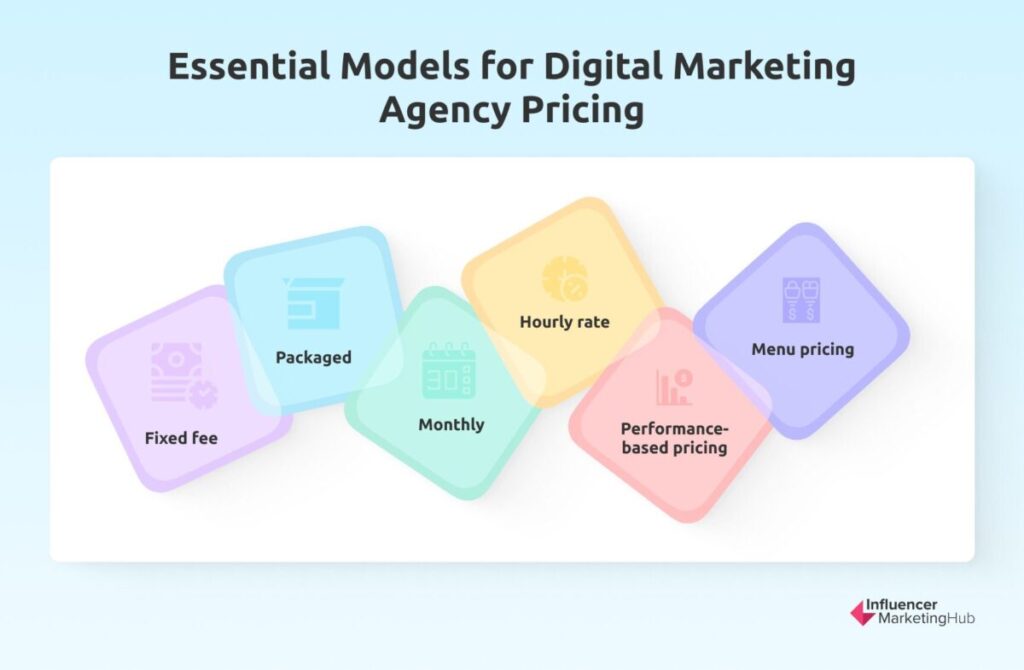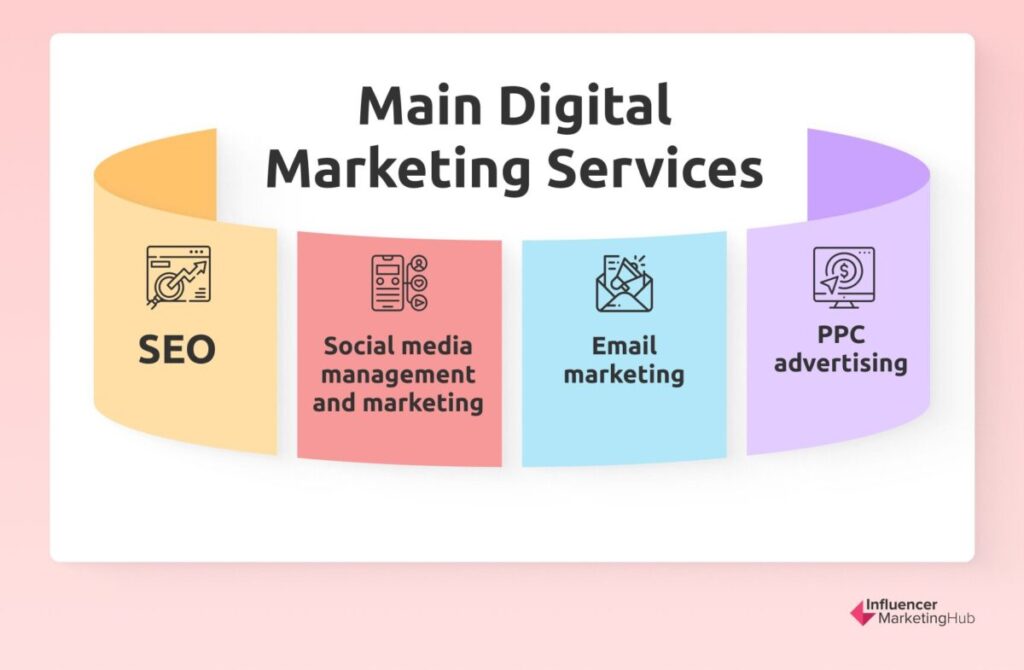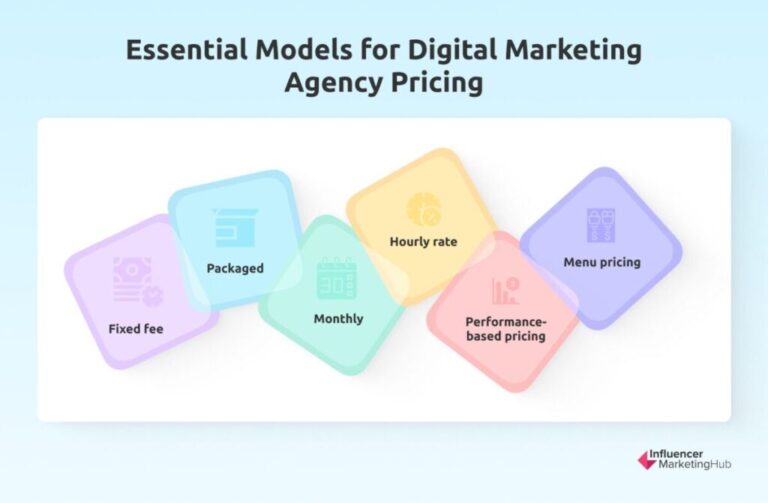The challenge with pricing digital marketing services is that they need to be priced competitively. However, the average cost of a particular service can vary widely, making it nearly impossible to determine an acceptable rate.
Whether you're an agency just starting out or an established agency looking to overhaul your pricing, here's an overview of the most common pricing models. We also include sample rates from major agencies in New York City and other major cities.
Digital marketing agency pricing: pricing models, average costs, and more:
Most common pricing model
Before deciding on your rates, first think about how you will charge your clients. Here are six of the most commonly used pricing models in the industry.

1. Fixed fee/project-based pricing
This is the most common pricing model. According to the Digital Agency Industry Report 2023 published by Promethean Research, more than 60% of agencies are using this option.
It's that simple. Clients are charged a fee per project, such as performing a website audit. You'll know the exact price in advance so there are no surprises.
However, it can be difficult to accurately estimate how much time and resources an agency will need to devote to a project. If they get it wrong, they will eventually have to absorb the loss.
Ideal if you primarily work with price-sensitive clients, such as small businesses. To use it, estimate how much your project will cost and add a margin to that amount.
2. Packaged/tiered pricing
If you want to sell the idea of selling additional services (something that's not really possible if you're using a fixed-fee pricing method), consider the idea of offering a marketing package. There are many different types of packages we can offer, from SEO to social media marketing to general digital marketing.
We combine a number of related marketing services and offer them as package deals at a variety of pricing. For example, an entry-level content marketing plan can include three pieces of content, but the next stage offers six pieces of content.
The challenge is to create it so that everything is clear. Clients need to be able to know exactly what is included, what is excluded, and what is available as an add-on.
You will also need a broad skill set to be able to provide a variety of services. For example, if you want to create a social media marketing package, you'll need to know the details of all the major platforms. Or perhaps you need to be highly skilled in one platform so that you can provide all the services you need to market in that channel.
It is predictable which will work better for both the client and the marketing agency. Service providers can enjoy a more stable inflow of payments, while clients can better budget.
Additionally, clients feel they get more value than paying for each service separately.
3. Monthly fee/retainer fee
This is similar to selling a marketing package. Clients pay a monthly fee to maintain the service. Service hours are limited to, for example, 40 hours per month.
The appeal of this approach is that you are guaranteed a percentage of your monthly income. However, getting companies to register is difficult.
4. Hourly wage
Billing for an hourly rate is easy, as is our fixed rate pricing structure. For example, identify an hourly rate, such as $100 per hour, and bill the client for the number of hours spent on the campaign.
Hourly rates can vary widely. Basically, anything between $75 and $250 per hour will apply.
One drawback is that it can be difficult to grow your business using only this pricing model. After all, there are only so many hours you can work in a month. Additionally, your billable hours could be even lower if you want to implement a four-day work week, an idea that is slowly gaining traction in the industry.
5. Performance-based pricing
Performance-based pricing charges you based on the goals you achieve. Use specific pre-agreed performance metrics such as page views, leads generated, and sales. In other words, if you don't produce results, you won't get paid.
6. Menu Pricing
Another less popular option is to price services individually. For example, you pay per blog post, social media profile optimization, or logo.
Bespoke services are usually cheaper than full-scale projects, making it easier to attract new customers. We also offer maximum flexibility to our clients. You can choose only the services you really need.
That said, it may not be the most cost-effective for the client. For example, you may decide to pay only for the actual social media posts and skip the strategizing. This could mean your content is missing the point.
average cost of service
Determining how much to charge is influenced by your monthly costs and what your competitors charge. The price of your services should be competitive from the beginning. If you're just starting out and are considering discounting your services to attract customers, keep in mind that it will be difficult to increase prices if it becomes a long-term partnership.
That being said, there really is no such thing as a standard fee when it comes to digital marketing pricing. Prices for most services tend to fluctuate widely.
Let's take video marketing as an example. According to Semrush, prices for short videos range from $4,000 to $35,000.
To help you price your services, here are some numbers to keep in mind for key strategies.

SEO
Ahrefs, one of the tools digital marketing agencies can use for SEO, surveyed over 400 professionals about SEO costs. Here's what this SEO research revealed:
- The average hourly wage is between $75 and $100.
- Project-based fees typically start at $2,500 and can often cost as much as $5,000.
- Retainer costs start at around $500 per month and can reach an average of $1,500 per month.
- Monthly flat rate is the most common pricing model. About 80% charge a monthly retainer.
However, according to Semrush numbers, it's not uncommon for average costs to exceed $100 per hour. In fact, you can charge $250 per hour and still be considered competitive.
Additionally, if you end up working with a large company, your monthly income could exceed $200,000.
Social media management and marketing
According to Sprout Social, rated as one of the top social media management tools for agencies, a comprehensive social media management plan can cost just over $12,000 per month. But when we interviewed more than 220 agencies about the cost of social media services, the majority (33%) said they charge between $1,500 and $3,000 per month.
Services typically included in this price include:
- Platform management
- strategy
- Content production
- analysis
- community management
Social media managers can earn up to $150 per hour.
If you're looking to offer content creation, the cost per post will be between $150 and $500.
email marketing
Email marketing is one of the main digital marketing services you may want to offer. However, it is not that expensive when compared to SEO and social media.
According to Email Vendor Selection, customers can expect to pay around $2,500 per month. For example, LYFE Marketing, rated as one of the top digital marketing agencies in the US, charges about $1,850 per month for 10 emails and 10 text blasts.
When it comes to average hourly rates for email marketing, most agencies charge between $100 and $200 per hour. For example, if an executive works on a campaign, the compensation can be close to $200. Alternatively, you can charge a blended rate, or the same hourly rate, regardless of which team members are assigned to the campaign.
Pay-per-click (PPC) advertising
PPC campaigns and email marketing more or less fall into the same price range. According to Semrush, the average monthly cost for a PPC campaign ranges from just $250 to $1,500. However, 310 Creative, one of the top B2B SEO agencies, claims that it is not uncommon for companies to spend thousands of dollars each month on their PPC campaigns. Between $5,000 and $10,000 is still a pretty average spend.
However, PPC works a little differently than other strategies. Due to its unique nature, it presents agencies with another possible pricing model and gives them the opportunity to charge a certain percentage of advertising costs. Based on 310 Creative numbers, this percentage typically ranges from 10% to 30%.
WebFX, one of the top agencies for small businesses, charges 12% to 15% of the advertising cost. There is also an initial optimization fee that ranges from $1,200 to $5,800 depending on the package.
This is an example of another potential revenue source: setup fees. It’s not uncommon for agencies to charge a one-time fee, not just for PPC but for other strategies as well.
profit potential
According to Promethean Research's Digital Agency Industry Report 2023, the number of digital agencies in the U.S. and Canada grew by 54% between 2018 and 2023. Not only have they grown in number, but they have also expanded in size.
In 2018, 21% had 11 to 50 full-time employees. Fast forward five years and 27% fall into that cohort.
So while there may be more competition, the statistics would like to suggest that there are still plenty of jobs available. One reason for this is that companies are investing a significant portion of their budgets in various digital transformation initiatives.
Gone are the days when budgets were primarily spent on websites and digital marketing. Companies are investing in areas such as customer experience (CX) and automation. Promethean Research predicts that spending on digital transformation will exceed $3 trillion by 2026.
Agencies are getting bigger and companies may be willing to spend more, but profit margins are getting smaller. Revenues spent on cost of goods and operating expenses each increased by 5%. This results in a pre-tax net profit of 17%. This number used to be as high as 35%.
There are two main reasons for this change. First of all, inflation is a big problem. Forbes reports that prices remain at least 20% higher across the board than they were two years ago. The inflation situation for UK marketing agencies is quite similar, if not worse.
Then there's salary pressure. To deal with this pressure, government agencies are using offshoring (relocating certain business processes to countries where labor is more affordable) and nearshoring (similar to offshoring, but where processes are moved to a neighboring country). ) can be considered. It is especially popular with large agencies and agencies of large companies.
In addition to considering offshoring and nearshoring, staying up to date with new features can also help move the needle in the right direction. The Digital Agency Industry Report 2023 found that brands have recently placed more emphasis on building their own in-house teams. But for now, new technologies like AI are creating new capabilities faster than companies can build internal teams.
Important points
A clear pricing model is key. That being said, some flexibility should be included.
Leave room for customization.
You can also apply multiple pricing models. For example, you can charge a fixed fee for a large portion of your project. Hourly rates can then be used for additional services.
But if you want to stay relevant, you can do more than just offer standard services. Consider including services centered around AI and customer experience that your company's internal marketing team may not yet have experience with or simply don't have enough data on.


